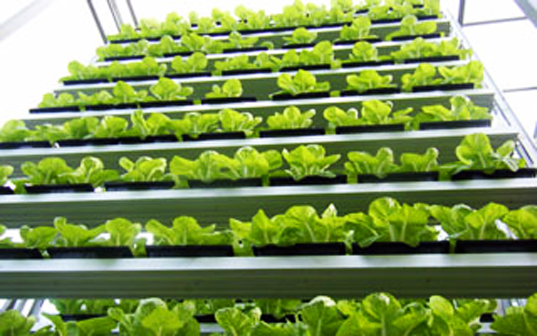Vertical Farms Provide A Ray Of Hope Amidst Declining Food Outputs
From the past few years, mankind has been plagued with very serious issues, one of them being a continuously declining farm output coupled with a growing urban population. One of the potential solutions to this problem can be "Vertical Farms". The UN predicts that around 86% of world population will be living in urban areas around 2050. Vertical Farms can provide a way to feed these rapidly inflating population groups as they can be grown in derelict buildings, unused warehouses, skyscrapers, and even in aircraft hangars. These farms are nothing but vast vertical stacks of plants, mainly green vegetables. Therefore using relatively low space, high output can be generated.
These plants are grown in soil-free systems (called hydroponics) that conserve water and are lit using LED lights that mimic sunlight. This entire process is choreographed using a control software that rotates stacks of plants to ensure that all of them get equal and sufficient light. Water pumps feed the nutrients to the plants uniformly. All these processes can be monitored using a smartphone. As long as the farms are kept away from pests, there is absolutely no reason to use any chemical herbicides or pesticides.

Many vertical farms have sprung up all over the world. A majority of them rely on natural sunlight for nutrition such as SkyGreens in Singapore. The glass-sided building is about 4 stories high. Inside, Chinese cabbage and lettuce plants take their turns to receive maximum sunlight using a low power elevator. In contrast, Nuvege in Kyoto, Japan employ LEDs. These LEDs emit light of a specific wavelength used by two types of chlorophyll- red chlorophyll and blue chlorophyll. Dickson Despommier – an ecologist at Columbia University in New York City, who has been advocating vertical farms since 1999, said, using LEDs tuned to the spectra of these two chlorophylls, plants can be grown anywhere. Despommier adds- Plants don't need an 'always-on' source of light. In fact, mimicking light changes like from dawn to noon to dusk provides same nutrition as that of sunlight and also helps save energy.
A flipside of using LEDs is the escalating electricity bill. Modern LEDs are about 28% efficient and thus are not very economical for this use. However, Phillips has demonstrated LEDs that are 68% efficient. This could cut down electricity costs. The advancements in this field, however, are not only fueled by a desire to feed the growing urban populace, but also for other uses such as research, disaster mitigation, emergency food supplies, etc. The US Defense Advanced Research Projects Agency uses an 18-storey vertical farm to produce genetically modified plants that make proteins useful in vaccines. Other uses can include: food supplies in long term relief camp or calamity-affected areas, medicinal plant supplies for pharmaceutical companies and so on.
These plants are grown in soil-free systems (called hydroponics) that conserve water and are lit using LED lights that mimic sunlight. This entire process is choreographed using a control software that rotates stacks of plants to ensure that all of them get equal and sufficient light. Water pumps feed the nutrients to the plants uniformly. All these processes can be monitored using a smartphone. As long as the farms are kept away from pests, there is absolutely no reason to use any chemical herbicides or pesticides.

Many vertical farms have sprung up all over the world. A majority of them rely on natural sunlight for nutrition such as SkyGreens in Singapore. The glass-sided building is about 4 stories high. Inside, Chinese cabbage and lettuce plants take their turns to receive maximum sunlight using a low power elevator. In contrast, Nuvege in Kyoto, Japan employ LEDs. These LEDs emit light of a specific wavelength used by two types of chlorophyll- red chlorophyll and blue chlorophyll. Dickson Despommier – an ecologist at Columbia University in New York City, who has been advocating vertical farms since 1999, said, using LEDs tuned to the spectra of these two chlorophylls, plants can be grown anywhere. Despommier adds- Plants don't need an 'always-on' source of light. In fact, mimicking light changes like from dawn to noon to dusk provides same nutrition as that of sunlight and also helps save energy.
A flipside of using LEDs is the escalating electricity bill. Modern LEDs are about 28% efficient and thus are not very economical for this use. However, Phillips has demonstrated LEDs that are 68% efficient. This could cut down electricity costs. The advancements in this field, however, are not only fueled by a desire to feed the growing urban populace, but also for other uses such as research, disaster mitigation, emergency food supplies, etc. The US Defense Advanced Research Projects Agency uses an 18-storey vertical farm to produce genetically modified plants that make proteins useful in vaccines. Other uses can include: food supplies in long term relief camp or calamity-affected areas, medicinal plant supplies for pharmaceutical companies and so on.
0
